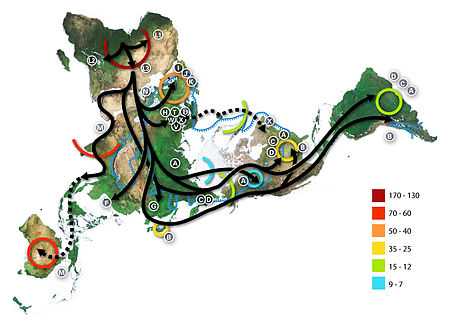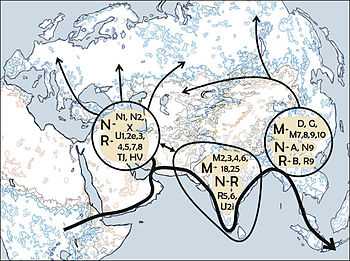Haplogroup A (mtDNA)
| Haplogroup A | |
|---|---|
 | |
| Possible time of origin | 132,000 ± 12,000 YBP[1] |
| Possible place of origin | Asia |
| Ancestor | N |
| Descendants | A3, A4, A5, A7, A8 |
| Defining mutations | 152, 235, 523-524d, 663, 1736, 4248, 4824, 8794, 16290, 16319[2] |
In human mitochondrial genetics, Haplogroup A is a human mitochondrial DNA (mtDNA) haplogroup.
Origin

Haplogroup A is believed to have arisen in Asia some 30,000–50,000 years before present. Its ancestral haplogroup was Haplogroup N.
Its highest frequencies are among Indigenous peoples of the Americas, its largest overall population is in East Asia, and its greatest variety (which suggests its origin point) is in East Asia. Thus, it might have originated in and spread from the Far East.[3]
Distribution
Its subgroup A2 (actually a subclade of A4, which is widespread in Asia) is found in Chukotko–Kamchatka[4] and is also one of five mtDNA haplogroups found in the indigenous peoples of the Americas, the others being B, C, D, and X.[3]
Haplogroup A2 is the most common haplogroup among the Inuit, Na-Denes, and many Amerind ethnic groups of North and Central America. Lineages belonging to haplogroup A2 also comprise the majority of the mtDNA pool of the Inuit and their neighbors, the Chukchis, in northeasternmost Siberia.[4][5][6]
Other branches of haplogroup A are less frequent but widespread among other populations of Asia.[7][8] In particular, haplogroup A4(xA2) is ubiquitous in populations from Siberia in the north to Iran and Vietnam in the south. Haplogroup A5, on the other hand, is rather limited to populations from Korea and Japan southward, though it has been detected as singletons in a pair of large samples of Khamnigans (1/99 = 1.0%) and Buryats (1/295 = 0.3%) from the Buryat Republic.[5]
In Asia, A(xA2) is especially frequent in Tibeto-Burman-speaking populations of Southwest China, such as Tibetans (6/65 = 9.2%,[4] 25/216 = 11.6%,[9] 11/73 = 15.1%[9]). Approximately 7% to 15% of Koreans belong to haplogroup A.[5][10][11] Approximately 5% to 12% of the Japanese belong to haplogroup A (including A4, A5, and A(xA4, A5)).[4][12][13][14] Approximately 4% to 13% of Mongols belong to haplogroup A, almost all of whom are contained within the A4 subclade (2/47 = 4.3% Mongolians from Ulan Bator in haplogroup A4,[10] 4/48 = 8.3% Mongols from New Barag Left Banner in haplogroup A(xA5),[11] 6/47 = 12.8% Mongolians from Ulan Bator in haplogroup A4[5]). Approximately 3% to 9% of Chinese people belong to haplogroup A.[12] Haplogroup A also has been found in Vietnamese (2/42 = 4.8%, including one A4 and one A5(xA5a)).[10] Approximately 4% (3/71) of Tatars from Aznakayevo,[15] 3% (4/126) of Tatars from Buinsk,[15] and 2% of Turkish people belong to haplogroup A.[16] Haplogroup A4 has been found in 2.4% (2/82) of a sample of Persians from eastern Iran and in 2.3% (1/44) of a sample of Tajiks from Tajikistan.[5] Haplogroup A is not found in Austronesians.[17]
Table of Frequencies of MtDNA Haplogroup A
Subclades
Tree
This phylogenetic tree of haplogroup A subclades is based on the paper by Mannis van Oven and Manfred Kayser Updated comprehensive phylogenetic tree of global human mitochondrial DNA variation[2] and subsequent published research.
- A
- A3
- A4
- A4a
- A4a1
- A4a1a
- A4a1
- A4b
- A4c
- A4c1
- A2
- A2a
- A2a2
- A2b
- A2b1
- A2c
- A2d
- A2d1
- A2d1a
- A2d2
- A2e
- A2f
- A2f1
- A2f1a
- A2f1
- A2g
- A2h
- A2i
- A2j
- A2j1
- A2k
- A2k1
- A2n
- A2p
- A2d1
- A2q
- A2a
- A6
- A4a
- A5
- A5a
- A5a1
- A5a1a
- A5a1a1
- A5a1a1a
- A5a1a1b
- A5a1a2
- A5a1a1
- A5a1b
- A5a1a
- A5a2
- A5a1
- A5b
- A5c
- A5a
- A7
- A8
- A9
Popular culture
The mummy "Juanita" of Peru, also called the "Ice Maiden", has been shown to belong to mitochondrial haplogroup A.[19][20]
In his popular book The Seven Daughters of Eve, Bryan Sykes named the originator of this mtDNA haplogroup Aiyana.
Eva Longoria, an American actress of Mexican descent is Haplogroup A2.
See also
- Genealogical DNA test
- Genetic Genealogy
- Human mitochondrial genetics
- Population Genetics
- Indigenous Amerindian genetics
- Sinforosa Amador
|
Evolutionary tree of human mitochondrial DNA (mtDNA) haplogroups | |||||||||||||||||||||||||||||||||||||
| Mitochondrial Eve (L) | |||||||||||||||||||||||||||||||||||||
| L0 | L1–6 | ||||||||||||||||||||||||||||||||||||
| L1 | L2 | L3 | L4 | L5 | L6 | ||||||||||||||||||||||||||||||||
| M | N | ||||||||||||||||||||||||||||||||||||
| CZ | D | E | G | Q | O | A | S | R | I | W | X | Y | |||||||||||||||||||||||||
| C | Z | B | F | R0 | pre-JT | P | U | ||||||||||||||||||||||||||||||
| HV | JT | K | |||||||||||||||||||||||||||||||||||
| H | V | J | T | ||||||||||||||||||||||||||||||||||
References
- ↑ Klyosov, A.; Rozhanskii, I (May 2012). "Re-Examining the "Out of Africa" Theory". Scientific Research: 80–86. doi:10.4236/aa.2012.22009.
- ↑ 2.0 2.1 van Oven, Mannis; Manfred Kayser (13 Oct 2008). "Updated comprehensive phylogenetic tree of global human mitochondrial DNA variation". Human Mutation 30 (2): E386–E394. doi:10.1002/humu.20921. PMID 18853457. Retrieved 2009-05-20.
- ↑ 3.0 3.1 Fagundes, Nelson J.R.; Ricardo Kanitz, Roberta Eckert, Ana C.S. Valls, Mauricio R. Bogo, Francisco M. Salzano, David Glenn Smith, Wilson A. Silva, Marco A. Zago, Andrea K. Ribeiro-dos-Santos, Sidney E.B. Santos, Maria Luiza Petzl-Erler, and Sandro L.Bonatto (2008). "Mitochondrial Population Genomics Supports a Single Pre-Clovis Origin with a Coastal Route for the Peopling of the Americas" (pdf). American Journal of Human Genetics 82 (3): 583–592. doi:10.1016/j.ajhg.2007.11.013. PMC 2427228. PMID 18313026. Retrieved 2009-11-19.
- ↑ 4.0 4.1 4.2 4.3 Tanaka, Masashi et al. (2004). "Mitochondrial Genome Variation in Eastern Asia and the Peopling of Japan". Genome Research 14 (10A): 1832–1850. doi:10.1101/gr.2286304. PMC 524407. PMID 15466285.
- ↑ 5.0 5.1 5.2 5.3 5.4 Miroslava Derenko, Boris Malyarchuk, Tomasz Grzybowski et al., "Phylogeographic Analysis of Mitochondrial DNA in Northern Asian Populations", Am. J. Hum. Genet. 2007;81:1025–1041. DOI: 10.1086/522933
- ↑ Natalia V. Volodko, Elena B. Starikovskaya, Ilya O. Mazunin et al., "Mitochondrial Genome Diversity in Arctic Siberians, with Particular Reference to the Evolutionary History of Beringia and Pleistocenic Peopling of the Americas", The American Journal of Human Genetics 82, 1084–1100, May 2008. DOI 10.1016/j.ajhg.2008.03.019.
- ↑ Ville N Pimenoff, David Comas, Jukka U Palo et al., "Northwest Siberian Khanty and Mansi in the junction of West and East Eurasian gene pools as revealed by uniparental markers", European Journal of Human Genetics (2008) 16, 1254–1264; doi:10.1038/ejhg.2008.101
- ↑ Noriyuki Fuku, Kyong Soo Park, Yoshiji Yamada et al., "Mitochondrial Haplogroup N9a Confers Resistance against Type 2 Diabetes in Asians", Am. J. Hum. Genet. 2007; 80:407–415. DOI: 10.1086/512202
- ↑ 9.0 9.1 Fuyun Ji, Mark S. Sharpley, Olga Derbeneva et al., "Mitochondrial DNA variant associated with Leber hereditary optic neuropathy and high-altitude Tibetans", PNAS (May 8, 2012), vol. 109, no. 19, 7391–7396. doi: 10.1073/pnas.1202484109
- ↑ 10.0 10.1 10.2 Han-Jun Jin, Chris Tyler-Smith and Wook Kim, "The Peopling of Korea Revealed by Analyses of Mitochondrial DNA and Y-Chromosomal Markers" PLoS ONE (2009)
- ↑ 11.0 11.1 Qing-Peng Kong, Yong-Gang Yao, Mu Liu et al., "Mitochondrial DNA sequence polymorphisms of five ethnic populations from northern China", Hum Genet (2003) 113 : 391–405. doi:10.1007/s00439-003-1004-7
- ↑ 12.0 12.1 Kazuo Umetsu, Masashi Tanaka, Isao Yuasa et al., "Multiplex amplified product-length polymorphism analysis of 36 mitochondrial single-nucleotide polymorphisms for haplogrouping of East Asian populations", Electrophoresis (2005), 26, 91–98. DOI 10.1002/elps.200406129
- ↑ Asari M et al., "Utility of haplogroup determination for forensic mtDNA analysis in the Japanese population", Leg Med (2007), doi:10.1016/j.legalmed.2007.01.007
- ↑ Zheng H-X, Yan S, Qin Z-D, Wang Y, Tan J-Z, et al. 2011 Major Population Expansion of East Asians Began before Neolithic Time: Evidence of mtDNA Genomes. PLoS ONE 6(10): e25835. doi:10.1371/journal.pone.0025835
- ↑ 15.0 15.1 Boris Malyarchuk, Miroslava Derenko, Galina Denisova, and Olga Kravtsova, "Mitogenomic Diversity in Tatars from the Volga-Ural Region of Russia", Mol. Biol. Evol. 27(10):2220–2226. (2010) doi:10.1093/molbev/msq065
- ↑ Marchani, EE; Watkins, WS; Bulayeva, K; Harpending, HC; Jorde, LB (2008). "Culture creates genetic structure in the Caucasus: Autosomal, mitochondrial, and Y-chromosomal variation in Daghestan". BMC genetics 9: 47. doi:10.1186/1471-2156-9-47. PMC 2488347. PMID 18637195.
- ↑ Kristina A. Tabbada, Jean Trejaut, Jun-Hun Loo et al., "Philippine Mitochondrial DNA Diversity: A Populated Viaduct between Taiwan and Indonesia?", Mol. Biol. Evol. 27(1):21–31. (2010) doi:10.1093/molbev/msp215
- ↑ Takehiro SATO, Tetsuya AMANO, Hiroko ONO et al., "Mitochondrial DNA haplogrouping of the Okhotsk people based on analysis of ancient DNA: an intermediate of gene flow from the continental Sakhalin people to the Ainu", Anthropological Science Vol. 117(3), 171–180, 2009.
- ↑ "The peopling of the Americas: Genetic ancestry influences health". Scientific American.
- ↑ "First Americans Endured 20,000-Year Layover – Jennifer Viegas, Discovery News". Retrieved 2009-11-18.
External links
- General
- Ian Logan's Mitochondrial DNA Site
- Mannis van Oven's Phylotree
- Haplogroup A